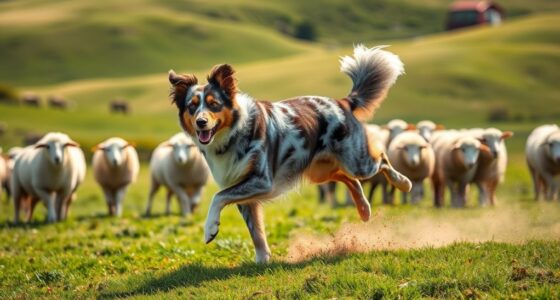Dachshunds may have a small frame, but their big personalities make them unforgettable companions. Bred in Germany for hunting small game, their long bodies and short legs are built for exploring tight tunnels. They’re lively, courageous, and fiercely loyal, often acting as brave watchdogs. Their playful, affectionate nature shines through, making them perfect family pets. If you want to discover more about what makes these little dogs so extraordinary, keep exploring their fascinating history and traits.
Key Takeaways
- Dachshunds have a small, elongated body designed for underground hunting, showcasing their practical and distinctive physical traits.
- Despite their small size, they possess a big personality—brave, lively, and fiercely loyal.
- Their alertness and bark make them excellent watchdogs, demonstrating a big heart for protecting their family.
- Intelligent and trainable, they quickly learn commands but may require patience due to their stubborn streak.
- Their playful, affectionate nature endears them as devoted companions with a big heart despite their small frame.

Have you ever wondered what makes the dachshund such a distinctive and beloved breed? Its unique appearance and lively personality set it apart from other small dogs. To truly understand what makes a dachshund special, you should look into its history origins and breed traits. These factors reveal why this little dog has remained a favorite for centuries and how its characteristics continue to charm dog lovers worldwide.
The history origins of the dachshund trace back hundreds of years in Germany. Originally, these dogs were bred for hunting small game like badgers and rabbits. Their long, low bodies allowed them to burrow into tight spaces, making them excellent diggers and persistent hunters. Over time, their breed traits—such as a fierce hunting instinct, alertness, and stamina—became well defined. They were valued not just for their hunting skills but also for their loyalty and intelligence. Their appearance, with a long body and short legs, was a deliberate trait to give them an advantage in underground pursuits, helping them navigate narrow tunnels. This practical design has persisted into modern times, making the dachshund instantly recognizable.
Breed traits of dachshunds highlight their lively, courageous, and sometimes stubborn nature. Despite their small size, they carry a big personality. They’re known for being brave and curious, often approaching new people or situations with confidence—sometimes a little too much! Their alertness makes them excellent watchdogs, quick to bark at unfamiliar sounds or strangers. You’ll also notice their playful and affectionate side, especially around their family. Dachshunds tend to form strong bonds with their owners, often acting as devoted companions. Their intelligence allows them to learn commands quickly, but they can also be a bit stubborn, so training requires patience and consistency. They’re energetic dogs that love to play, explore, and be involved in family activities, which keeps them happy and healthy.
Their breed traits extend beyond personality. Dachshunds come in different coat types—smooth, long-haired, and wire-haired—and a variety of colors, but their distinctive long body and expressive face are universal. Their physical traits aren’t just charming; they’re part of their functional design rooted in their origins. Whether you’re considering adopting one or just want to understand their nature better, recognizing these breed traits helps you appreciate the unique qualities that make dachshunds such an enduring breed.
Additionally, understanding their diverse design options can help owners choose a dachshund that best fits their lifestyle and home environment. In short, the history origins and breed traits of dachshunds explain why they’re so much more than just small dogs. They’re resilient, intelligent, and fiercely loyal animals that carry a rich legacy of hunting and companionship. Knowing these details gives you a deeper appreciation for their unique character and the special place they hold in many hearts around the world.
Frequently Asked Questions
Are Dachshunds Suitable for Apartment Living?
Yes, dachshunds are suitable for apartment living due to their apartment compatibility and small space requirements. They adapt well to smaller environments as long as they get regular exercise and mental stimulation. You should provide daily walks and playtime to keep them happy and healthy. Their friendly, social nature also makes them great companions in close quarters, ensuring they thrive even in limited space.
What Are Common Health Issues in Dachshunds?
You should be aware that dachshunds are prone to genetic disorders like intervertebral disc disease, which affects their spine and mobility. They also often face dental problems, so regular brushing and dental check-ups are essential. These health issues highlight the importance of routine vet visits and a healthy diet. Staying vigilant helps you catch problems early and keeps your dachshund happy and comfortable.
How Much Exercise Does a Dachshund Need Daily?
You should give your dachshund about 30 to 60 minutes of exercise daily, depending on their age and energy level. Their exercise needs include brisk walks, playtime, and mental stimulation to keep them healthy and happy. Daily activity levels help prevent obesity and related health issues, so make sure to tailor activities to your dachshund’s individual needs. Regular exercise also keeps their big heart healthy and strong.
What Is the Average Lifespan of a Dachshund?
They say “you are what you eat,” and this holds true for your dachshund’s longevity. On average, a dachshund’s lifespan is around 12 to 16 years. Factors like diet, exercise, genetics, and veterinary care influence their lifespan. To guarantee your small friend lives a full, happy life, provide proper nutrition, regular check-ups, and plenty of love. Remember, a healthy lifestyle boosts your pup’s chances for a longer, happier life.
Are Dachshunds Good With Children and Other Pets?
Yes, dachshunds are generally good with children and other pets when socialized early. You’ll find their child compatibility improves with gentle handling and supervision. They thrive on positive pet interactions, but their bold personality means you should teach kids respectful behavior. Keep in mind, some dachshunds may be territorial or wary of unfamiliar animals, so gradual introductions and consistent training help guarantee harmony in your household.
Conclusion
As you look into a dachshund’s eyes, you realize their big heart often matches their small frame—just like how you might find comfort in unexpected places. It’s funny how life brings these tiny bundles of love into your world when you least expect it, reminding you that size doesn’t matter. With every wag of their tail, they prove that even the smallest friends can make the biggest difference in your life.










